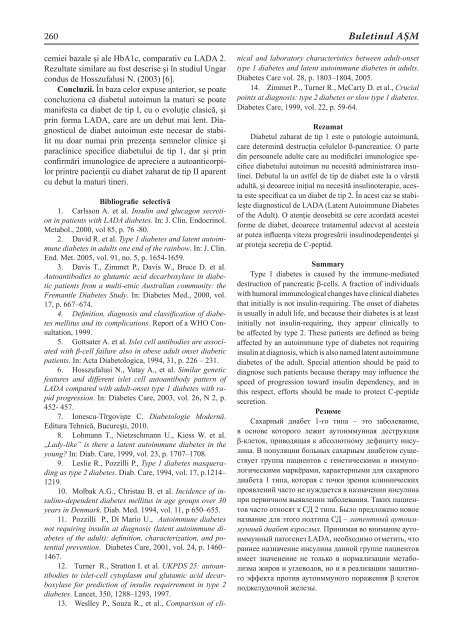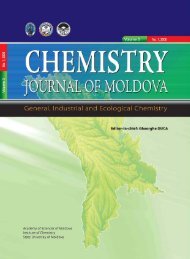2011, nr. 3 - Academia de ÅtiinÅ£e a Moldovei
2011, nr. 3 - Academia de ÅtiinÅ£e a Moldovei
2011, nr. 3 - Academia de ÅtiinÅ£e a Moldovei
Create successful ePaper yourself
Turn your PDF publications into a flip-book with our unique Google optimized e-Paper software.
260cemiei bazale şi ale HbA1c, comparativ cu LADA 2.Rezultate similare au fost <strong>de</strong>scrise şi în studiul Ungarcondus <strong>de</strong> Hosszufalusi N. (2003) [6].Concluzii. În baza celor expuse anterior, se poateconcluziona că diabetul autoimun la maturi se poatemanifesta ca diabet <strong>de</strong> tip I, cu o evoluţie clasică, şiprin forma LADA, care are un <strong>de</strong>but mai lent. Diagnosticul<strong>de</strong> diabet autoimun este necesar <strong>de</strong> stabilitnu doar numai prin prezenţa semnelor clinice şiparaclinice specifice diabetului <strong>de</strong> tip 1, dar şi princonfirmări imunologice <strong>de</strong> apreciere a autoanticorpilorprintre pacienţii cu diabet zaharat <strong>de</strong> tip II aparentcu <strong>de</strong>but la maturi tineri.Bibliografie selectivă1. Carlsson A. et al. Insulin and glucagon secretionin patients with LADA diabetes. In: J. Clin. Endocrinol.Metabol., 2000, vol 85, p. 76 -80.2. David R. et al. Type 1 diabetes and latent autoimmunediabetes in adults one end of the rainbow. In: J. Clin.End. Met. 2005, vol. 91, no. 5, p. 1654-1659.3. Davis T., Zimmet P., Davis W., Bruce D. et al.Autoantibodies to glutamic acid <strong>de</strong>carboxylase in diabeticpatients from a multi-etnic Australian community: theFremantle Diabetes Study. In: Diabetes Med., 2000, vol.17, p. 667–674.4. Defi nition, diagnosis and classifi cation of diabetesmellitus and its complications. Report of a WHO Consultation,1999.5. Gottsater A. et al. Islet cell antibodies are associatedwith β-cell failure also in obese adult onset diabeticpatients. In: Acta Diabetologica, 1994, 31, p. 226 – 231.6. Hosszufalusi N., Vatay A., et al. Similar geneticfeatures and different islet cell autoantibody pattern ofLADA compared with adult-onset type 1 diabetes with rapidprogression. In: Diabetes Care, 2003, vol. 26, N 2, p.452- 457.7. Ionescu-Tîrgovişte C. Diabetologie Mo<strong>de</strong>rnă.Editura Tehnică, Bucureşti, 2010.8. Lohmann T., Nietzschmann U., Kiess W. et al.„Lady-like” is there a latent autoimmune diabetes in theyoung? In: Diab. Care, 1999, vol. 23, p. 1707–1708.9. Leslie R., Pozzilli P., Type 1 diabetes masqueradingas type 2 diabetes. Diab. Care, 1994, vol. 17, p.1214–1219.10. Molbak A.G., Christau B. et al. Inci<strong>de</strong>nce of insulino-<strong>de</strong>pen<strong>de</strong>ntdiabetes mellitus in age groups over 30years in Denmark. Diab. Med. 1994, vol. 11, p 650–655.11. Pozzilli P., Di Mario U., Autoimmune diabetesnot requiring insulin at diagnosis (latent autoimmune diabetesof the adult): <strong>de</strong>fi nition, characterization, and potentialprevention. Diabetes Care, 2001, vol. 24, p. 1460–1467.12. Turner R., Stratton I. et al. UKPDS 25: autoantibodiesto islet-cell cytoplasm and glutamic acid <strong>de</strong>carboxylasefor prediction of insulin requirrement in type 2diabetes. Lancet, 350, 1288–1293, 1997.13. Weslley P., Souza R., et al., Comparison of cli-Buletinul AŞMnical and laboratory characteristics between adult-onsettype 1 diabetes and latent autoimmune diabetes in adults.Diabetes Care vol. 28, p. 1803–1804, 2005.14. Zimmet P.., Turner R., McCarty D. et al., Crucialpoints at diagnosis: type 2 diabetes or slow type 1 diabetes.Diabetes Care, 1999, vol. 22, p. 59-64.RezumatDiabetul zaharat <strong>de</strong> tip 1 este o patologie autoimună,care <strong>de</strong>termină <strong>de</strong>strucţia celulelor ß-pancreatice. O partedin persoanele adulte care au modificări imunologice specificediabetului autoimun nu necesită administrarea insulinei.Debutul la un astfel <strong>de</strong> tip <strong>de</strong> diabet este la o vârstăadultă, şi <strong>de</strong>oarece iniţial nu necesită insulinoterapie, acestaeste specificat ca un diabet <strong>de</strong> tip 2. În acest caz se stabileştediagnosticul <strong>de</strong> LADA (Latent Autoimmune Diabetesof the Adult). O atenţie <strong>de</strong>osebită se cere acordată acesteiforme <strong>de</strong> diabet, <strong>de</strong>oarece tratamentul a<strong>de</strong>cvat al acesteiaar putea influenţa viteza progresării insulino<strong>de</strong>pen<strong>de</strong>nţei şiar proteja secreţia <strong>de</strong> C-peptid.SummaryType 1 diabetes is caused by the immune-mediated<strong>de</strong>struction of pancreatic β-cells. A fraction of individualswith humoral immunological changes have clinical diabetesthat initially is not insulin-requiring. The onset of diabetesis usually in adult life, and because their diabetes is at leastinitially not insulin-requiring, they appear clinically tobe affected by type 2. These patients are <strong>de</strong>fined as beingaffected by an autoimmune type of diabetes not requiringinsulin at diagnosis, which is also named latent autoimmunediabetes of the adult. Special attention should be paid todiagnose such patients because therapy may influence thespeed of progression toward insulin <strong>de</strong>pen<strong>de</strong>ncy, and inthis respect, efforts should be ma<strong>de</strong> to protect C-pepti<strong>de</strong>secretion.РезюмеСахарный диабет 1-го типа – это заболевание,в основе которого лежит аутоиммунная деструкцияβ-клеток, приводящая к абсолютному дефициту инсулина.В популяции больных сахарным диабетом существуетгруппа пациентов с генетическими и иммунологическимимаркёрами, характерными для сахарногодиабета 1 типа, которая с точки зрения клининческихпроявлений часто не нуждается в назначении инсулинапри первичном выявлении заболевания. Таких пациентовчасто относят к СД 2 типа. Было предложено новоеназвание для этого подтипа СД – латентный аутоиммунныйдиабет взрослых. Принимая во внимание аутоиммунныйпатогенез LADA, необходимо отметить, чтораннее назначение инсулина данной группе пациентовимеет значенение не только в нормализации метаболизмажиров и углеводов, но и в реализации защитногоэффекта против аутоиммуного поражения β клетокподжелудочной железы.
















